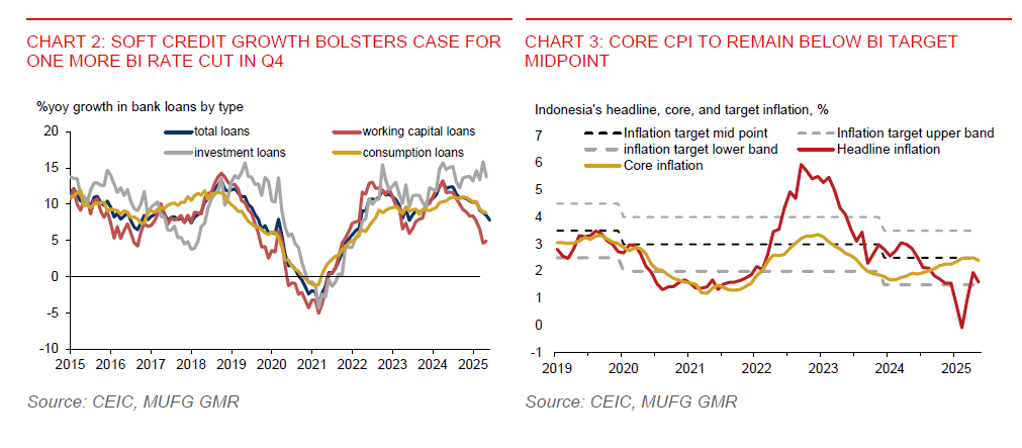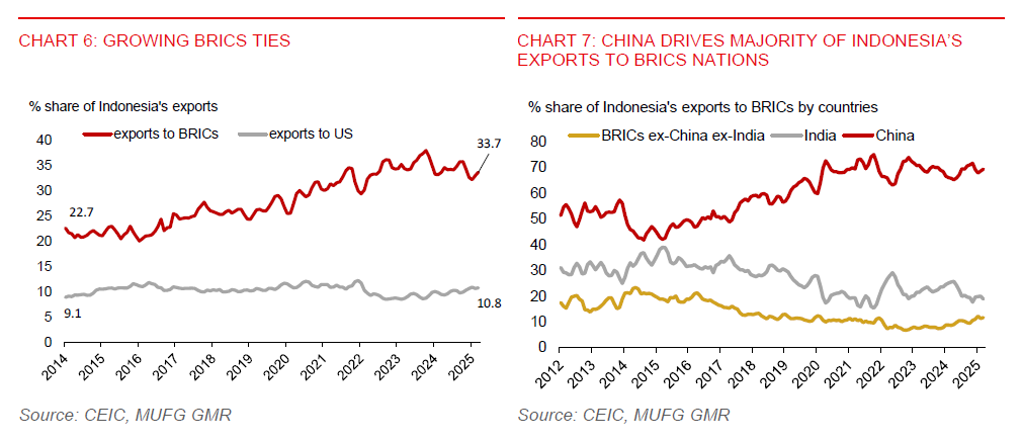Key Points
Please click on download PDF above for full report
- Bank Indonesia (BI) cut its benchmark policy rate by 25bps to 5.25% at its 16 July policy meeting, following a dovish hold in June. The move is in line with our expectation, although market consensus had anticipated a pause. With the rupiah remaining stable since the June meeting and broadly tracking regional trends, the central bank has seized the opportunity to provide additional support to the economy.
- Bank Indonesia has reiterated the need for continued monetary policy support amid a pickup in global trade uncertainty following Trump’s latest reciprocal tariff announcements. The central bank has also flagged downside risks to global growth, while maintaining its outlook for Indonesia’s GDP growth at 4.6%-5.4% in 2025.
- Bank Indonesia appears to have become more dovish at the policy meeting. It has signalled that lending rates need to continue declining. Credit growth had moderated further to 7.77%yoy in June, down from 8.4%yoy in May. Additionally, BI expects core inflation to come in lower than the target midpoint. We now factor in one more 25bps rate cut in Q4, bringing the BI-rate down to 5%. The easing cycle could potentially extend to 4.50% in 2026, which we view as the potential terminal rate of this easing cycle. BI continues to project lending growth of 8%-11% in 2025, reinforcing the likelihood of further monetary policy easing before year-end.
- We expect the US-Indonesia trade deal to contain downside risks to the rupiah, as Indonesia’s economy is likely to slow less than previously anticipated under Trump’s earlier proposed 32% reciprocal tariff rate. The trade agreement could help support market sentiment, supporting capital inflows into the government bond market. Combined with our anticipation for a resumption of Fed rate cuts in September and a weaker US dollar, we forecast the rupiah to appreciate to IDR15,700/USD by Q2 2026.
- President Trump has announced a bilateral trade agreement with Indonesia, reducing the reciprocal tariff rate on Indonesia to 19%, down from the 32% stated in his initial tariff letter, though still above the 10% baseline rate implemented since April. This lower tariff adjustment underscores the tactical nature of Trump’s trade negotiations, and we expect the 19% rate to remain in place for now. Notably, the new rate is slightly below the 20% tariff applied to Vietnam. As part of the trade deal, Indonesia has agreed to eliminate all levies on US imports and commit to purchasing more than $19bn worth of US goods including $15bn in energy products, $4.5bn in agriculture, and 50 Boeing aircrafts.
- Following the trade deal announcement, we have revised our baseline assumption for the US tariff rate on Indonesia to 19%, down from the previous 32%. As a result, we have slightly raised our 2025 GDP growth forecast for Indonesia to 4.7% (from 4.6% previously) and our 2026 outlook to 4.8% (from 4.6% previously).
- A key downside risk to Indonesia’s economic growth stems from President Trump’s threat of imposing 10% tariff on BRICs nations, driven by concerns that BRICS are looking to reduce reliance on the US dollar. Indonesia could be affected, having officially joined BRICs as a full member in January 2025. Indonesia’s export exposure to BRICS economies has grown significantly. Its share of exports to BRICS member countries has risen by 11 percentage points to 33.7% since March 2014, compared to just a 1.7 percentage point increase in its export share to the US. China accounts for the bulk of this shift, representing nearly 70% of Indonesia’s total exports to BRICS countries.



